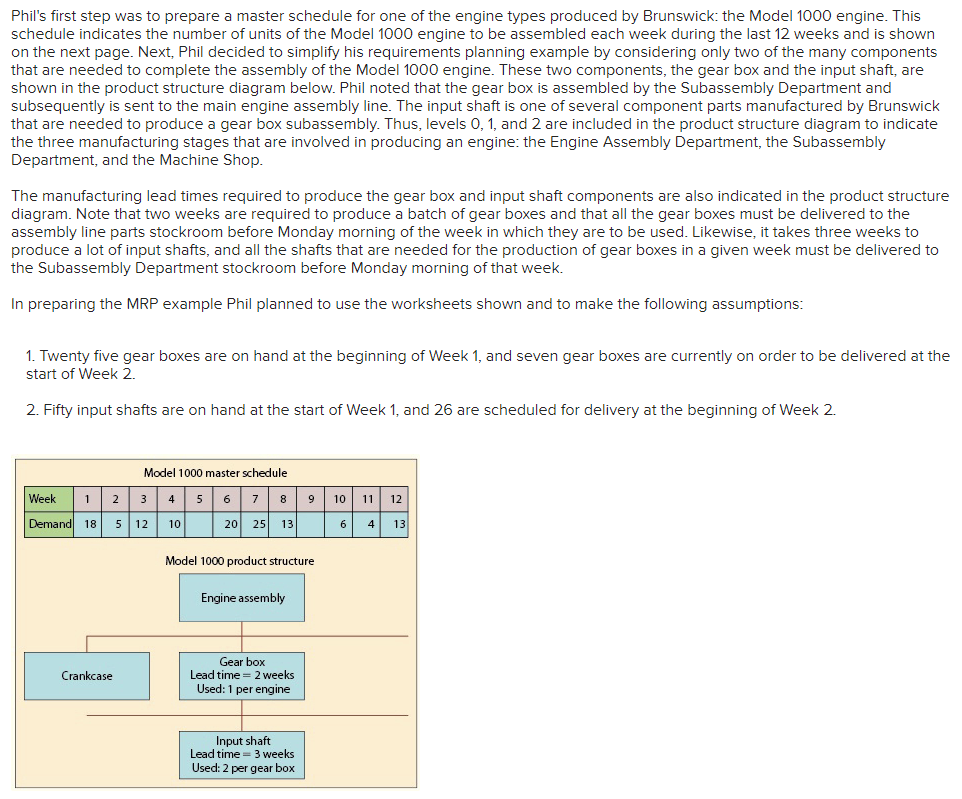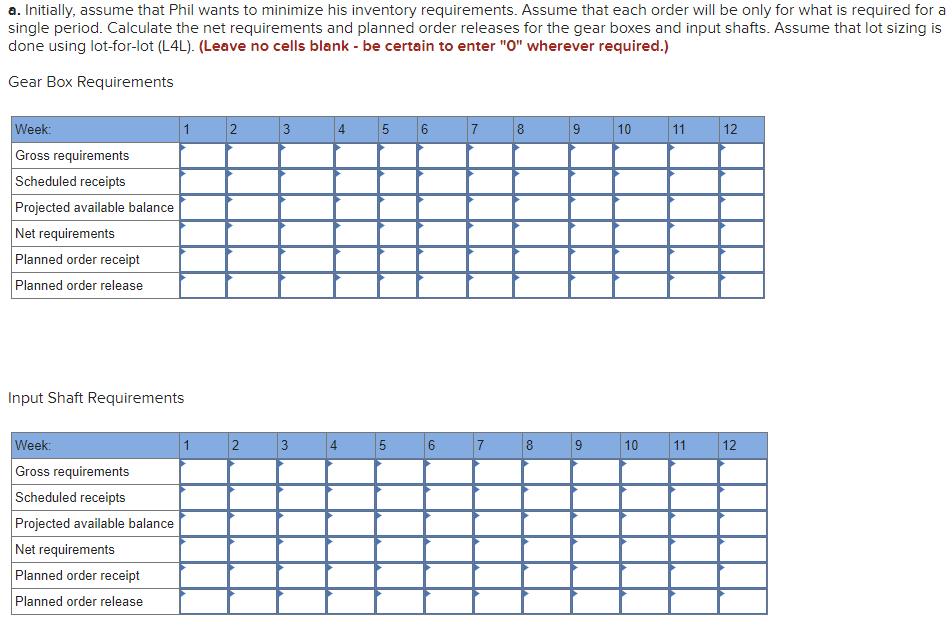a. Initially, assume that Phil wants to minimize his inventory requirements. Assume that each order will be only for what is required for a single period. Calculate the net requirements and planned order releases for the gear boxes and input shafts. Assume that lot sizing is done using lot-for-lot (L4L). (Leave no cells blank - be certain to enter "O" wherever required.) Gear Box Requirements 7 8 Week: Gross requirements Scheduled receipts Projected available balance Net requirements Planned order receipt Planned order release 2 3 4 5 6 9 10 11 12 Input Shaft Requirements Week: 2 3 5 6 7 8 9 10 11 12 Gross requirements Scheduled receipts Projected available balance Net requirements Planned order receipt Planned order release
a. Initially, assume that Phil wants to minimize his inventory requirements. Assume that each order will be only for what is required for a single period. Calculate the net requirements and planned order releases for the gear boxes and input shafts. Assume that lot sizing is done using lot-for-lot (L4L). (Leave no cells blank - be certain to enter "O" wherever required.) Gear Box Requirements 7 8 Week: Gross requirements Scheduled receipts Projected available balance Net requirements Planned order receipt Planned order release 2 3 4 5 6 9 10 11 12 Input Shaft Requirements Week: 2 3 5 6 7 8 9 10 11 12 Gross requirements Scheduled receipts Projected available balance Net requirements Planned order receipt Planned order release
Practical Management Science
6th Edition
ISBN:9781337406659
Author:WINSTON, Wayne L.
Publisher:WINSTON, Wayne L.
Chapter4: Linear Programming Models
Section: Chapter Questions
Problem 111P
Related questions
Question

Transcribed Image Text:Phil's first step was to prepare a master schedule for one of the engine types produced by Brunswick: the Model 1000 engine. This
schedule indicates the number of units of the Model 1000 engine to be assembled each week during the last 12 weeks and is shown
on the next page. Next, Phil decided to simplify his requirements planning example by considering only two of the many components
that are needed to complete the assembly of the Model 1000 engine. These two components, the gear box and the input shaft, are
shown in the product structure diagram below. Phil noted that the gear box is assembled by the Subassembly Department and
subsequently is sent to the main engine assembly line. The input shaft is one of several component parts manufactured by Brunswick
that are needed to produce a gear box subassembly. Thus, levels 0, 1, and 2 are included in the product structure diagram to indicate
the three manufacturing stages that are involved in producing an engine: the Engine Assembly Department, the Subassembly
Department, and the Machine Shop.
The manufacturing lead times required to produce the gear box and input shaft components are also indicated in the product structure
diagram. Note that two weeks are required to produce a batch of gear boxes and that all the gear boxes must be delivered to the
assembly line parts stockroom before Monday morning of the week in which they are to be used. Likewise, it takes three weeks to
produce a lot of input shafts, and all the shafts that are needed
the Subassembly Department stockroom before Monday morning of that week.
the production of gear boxes in a given week must be delivered to
In preparing the MRP example Phil planned to use the worksheets shown and to make the following assumptions:
1. Twenty five gear boxes are on hand at the beginning of Week 1, and seven gear boxes are currently on order to be delivered at the
start of Week 2.
2. Fifty input shafts are on hand at the start of Week 1, and 26 are scheduled for delivery at the beginning of Week 2.
Model 1000 master schedule
Week
1
2
3
4
5
6
7
8
9
10
11
12
Demand 18
12
10
20
25
13
6
4
13
Model 1000 product structure
Engine assembly
Gear box
Lead time = 2 weeks
Used: 1 per engine
Crankcase
Input shaft
Lead time = 3 weeks
Used: 2 per gear box

Transcribed Image Text:a. Initially, assume that Phil wants to minimize his inventory requirements. Assume that each order will be only for what is required for a
single period. Calculate the net requirements and planned order releases for the gear boxes and input shafts. Assume that lot sizing is
done using lot-for-lot (L4L). (Leave no cells blank - be certain to enter "0" wherever required.)
Gear Box Requirements
Week:
1
3
4
5
7
9
10
11
12
Gross requirements
Scheduled receipts
Projected available balance
Net requirements
Planned order receipt
Planned order release
Input Shaft Requirements
Week:
1
5
6
8
9
10
12
Gross requirements
Scheduled receipts
Projected available balance
Net requirements
Planned order receipt
Planned order release
11
3.
2.
Expert Solution
This question has been solved!
Explore an expertly crafted, step-by-step solution for a thorough understanding of key concepts.
This is a popular solution!
Trending now
This is a popular solution!
Step by step
Solved in 2 steps with 4 images

Recommended textbooks for you

Practical Management Science
Operations Management
ISBN:
9781337406659
Author:
WINSTON, Wayne L.
Publisher:
Cengage,

Practical Management Science
Operations Management
ISBN:
9781337406659
Author:
WINSTON, Wayne L.
Publisher:
Cengage,